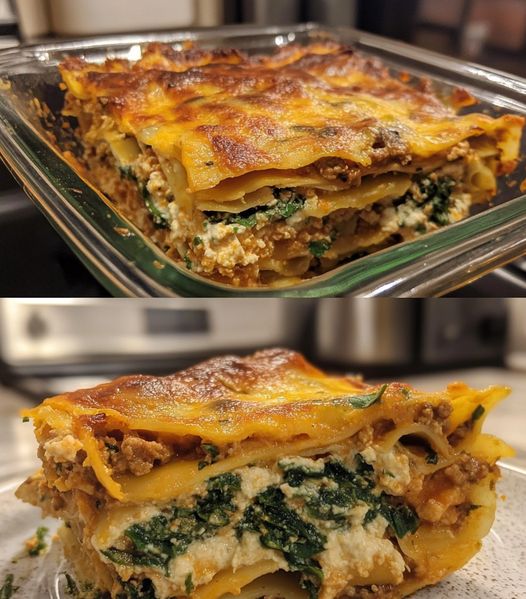Instructions
1. Prepare the Vegan Ricotta:
Start by draining the soaked or boiled almonds. Transfer the almonds to a food processor, along with the nutritional yeast, lemon juice, garlic, and water. Blend until smooth, pausing occasionally to scrape down the sides of the food processor. The consistency should be thick, creamy, and slightly grainy, mimicking traditional ricotta cheese. Taste and season with salt and pepper as needed. Set aside.
2. Cook the Lasagna Noodles:
Bring a large pot of salted water to a boil. Add the lasagna noodles and cook until al dente, according to the package instructions. Stir occasionally to prevent the noodles from sticking together. Once cooked, drain the noodles and lay them flat on a clean kitchen towel to cool. This step ensures they don’t stick to each other.
3. Sauté the Spinach:
In a large skillet, heat the olive oil over medium heat. Add the diced onion and cook for about 5 minutes until softened and translucent. Stir in the garlic and cook for another minute, until fragrant. Add the chopped spinach, dried oregano, dried basil, and red pepper flakes (if using). Cook for 3-4 minutes, or until the spinach has wilted. Season with salt and pepper, then remove from heat and set aside.
4. Assemble the Lasagna:
Preheat your oven to 375°F (190°C). Spread a thin layer of marinara sauce on the bottom of a 9×13-inch baking dish. Lay three lasagna noodles over the sauce, slightly overlapping them. Spread one-third of the vegan ricotta mixture over the noodles, followed by a layer of sautéed spinach. Spoon a generous amount of marinara sauce over the spinach. Repeat the layers (noodles, ricotta, spinach, sauce) two more times.
For the final layer, top with the last set of noodles, a generous amount of marinara sauce, and sprinkle with vegan mozzarella cheese if desired. The cheese will give the lasagna a bubbly, golden finish.
5. Bake the Lasagna:
Cover the lasagna with foil (to prevent the top from drying out) and bake for 30 minutes. After 30 minutes, remove the foil and bake for an additional 10-15 minutes, or until the top is golden and bubbling. If using vegan mozzarella, make sure it has melted to your liking.
6. Rest and Serve:
Once the lasagna is done, remove it from the oven and let it rest for 10 minutes. This allows the layers to set, making it easier to slice and serve. Garnish with fresh basil or parsley if desired.
Nutritional Information (Per Serving, based on 8 servings):
- Calories: ~360 kcal
- Carbohydrates: 42g
- Protein: 13g
- Fat: 16g
- Saturated Fat: 3g
- Fiber: 6g
- Sugars: 8g
- Calcium: 100mg
- Iron: 3.5mg
- Vitamin C: 15mg
- Potassium: 650mg
Tips for Success
- Vegan Ricotta Texture: If your ricotta is too thick, add a little more water to reach your desired creaminess. You want it to be smooth but still retain a slightly grainy texture like traditional ricotta.
- Perfect Noodle Cooking: Be sure to cook the noodles just until al dente. Overcooked noodles will become mushy during baking, so aim for slightly undercooked pasta that will absorb moisture from the sauce while baking.
- Extra veggies: Feel free to add more vegetables to the filling, such as mushrooms, zucchini, or roasted red peppers. This will increase the nutrient content and add even more flavor.
- Storage: Leftover lasagna can be stored in the refrigerator for up to 4 days. It also freezes well for up to 2 months. To reheat, simply thaw overnight in the fridge and bake in a 350°F (175°C) oven for 20-25 minutes, or until heated through.
- Make It Gluten-Free: For a gluten-free lasagna, simply use gluten-free lasagna noodles. The rest of the ingredients are naturally gluten-free.
- Cheese Variations: If you prefer, you can swap out the vegan mozzarella for a homemade cashew cheese or skip the cheese altogether for a more classic marinara lasagna.
Why This Recipe Works:
This vegan lasagna offers a creamy, savory, and completely satisfying experience while staying entirely plant-based. The almond ricotta provides a rich, nutty flavor that pairs beautifully with the spinach and marinara sauce. The lasagna noodles provide structure, while the marinara sauce brings all the layers together with a tangy, umami-rich finish. Whether you’re serving this to vegans or non-vegans, this dish is guaranteed to be a hit at the dinner table!
You can personalize this recipe with various additions, such as swapping the spinach for kale or collard greens, or adding layers of grilled vegetables like eggplant or zucchini. The versatility of the lasagna allows you to experiment with different sauces, such as a creamy vegan béchamel in place of marinara. Whatever adjustments you make, this dish will maintain its hearty and comforting appeal.

